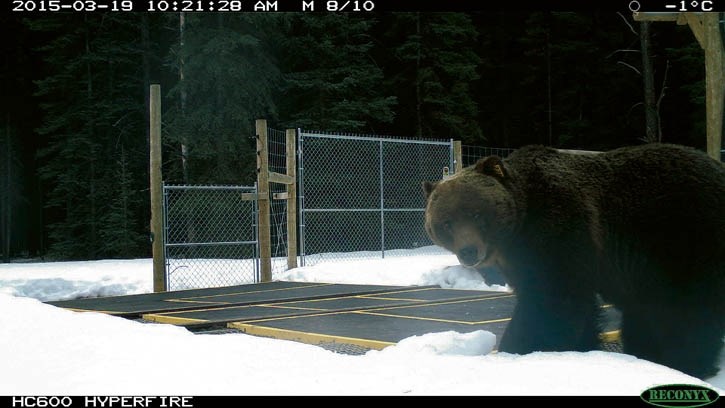The bears are out in Banff. Bear 122, the large dominant male in the Bow Valley, was captured on a remote camera near Castle Mountain at about 10:20 a.m. on Thursday (March 19). He has since been spotted almost daily.
He has been spending most of his time in the area between Castle Mountain and Eldon Siding to the west, primarily travelling along the railway corridor in search of food, including spilled grain along the tracks.
“It’s a great reminder we are back into bear season,” said Brianna Burley, a human-wildlife conflict specialist for Lake Louise, Yoho and Kootenay. “It’s time to dust off the bear spray and make sure it’s working and brush up on bear safety.”
Bear 122 is an approximately 300-kilogram bruin believed to be about 15 years old.
He is famous for hunting and eating a black bear near the Banff townsite in 2013, and more recently, when DNA work confirmed he had fathered at least five young bears in the Bow Valley.
Bear 122 was caught on a remote camera last week in an area where ongoing research is being conducted as part of the Parks Canada-Canadian Pacific Railway joint action plan to try to reduce the number of bears dying on the train tracks.
There have been 14 known grizzly bear deaths on the railway in Banff and Yoho since 2000, but that number does not take into account bears that may have been struck, but never found.
As part of the joint action plan, Canadian Pacific contributed $1 million to support various research projects to better understand the causes of bear-train collisions and come up with mitigation plans.
Research includes looking at the feasibility of fencing, a GPS collaring program to monitor grizzly bears, use of prescribed fire to draw bears away from the tracks, and investigation of other factors, other than grain, that may lead bears to travel near the tracks.
Burley said CP is in the process of bringing out the vacuum truck to scoop up grain.
“CP is aware of the bear in that area, which is good,” Burley said. “We have our regular concerns with bears on the railway tracks.”
Bear 122 was also the first bear spotted out of the den last year – on March 16.
Large males tend to be the first out, and as early as mid-March to early April is average for this area. Females with cubs tend to be the last out, around early May or sometimes even into early June.
Burley said none the eight bears fitted with GPS collars are out of their dens yet, but there may be other bears out.
She said bears are hungry and looking for food, including vegetation and carrion.
“They are looking for anything they can find, “Burley said. “This is the time of year when people and bears are more likely to bump into each in the lower elevations.”
Parks Canada reminds people to travel in groups and make noise, keep dogs on leash, carry bear spray and know how to use it. It is a good idea to make sure your bear spray is not expired and that it didn’t freeze over winter.
Bear sightings should be reported to Banff Dispatch at 403-762-1470.




